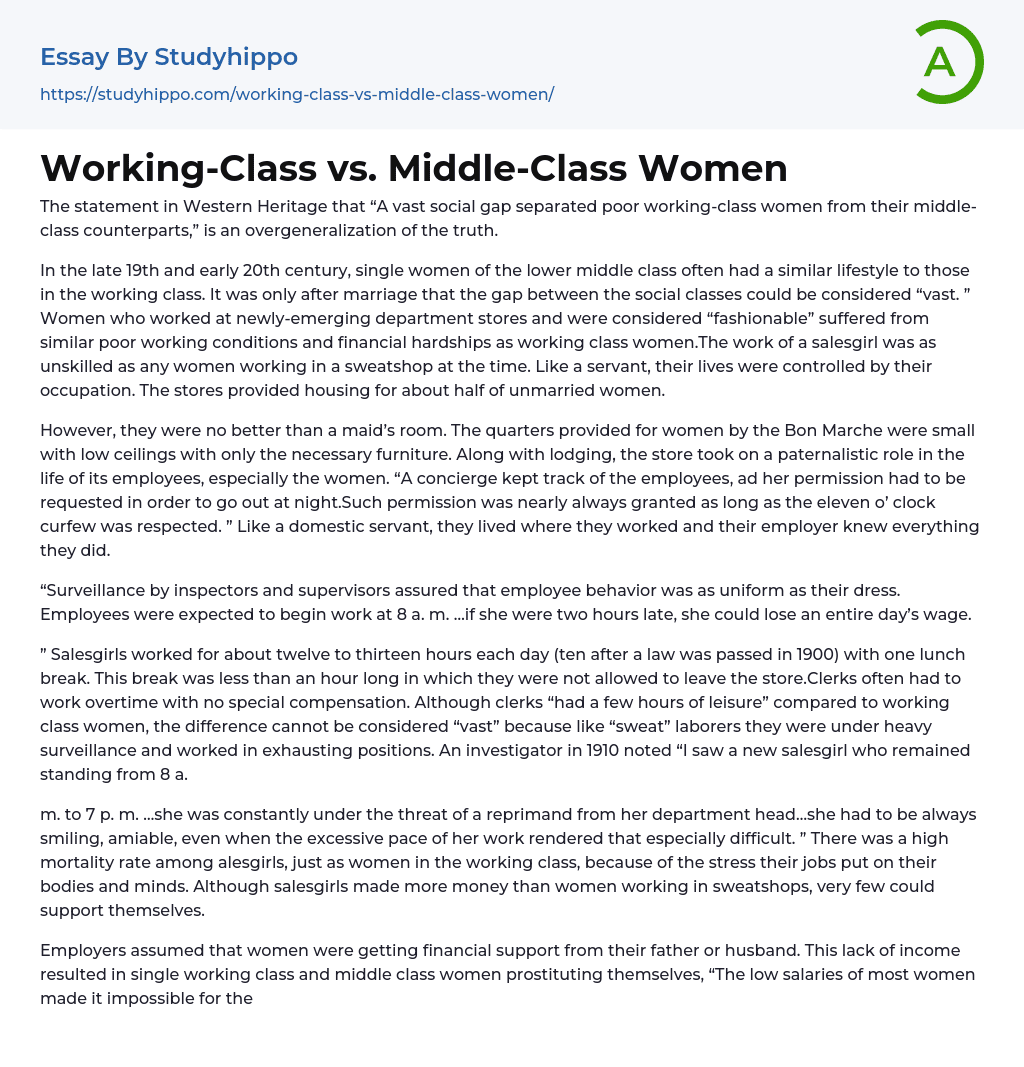The statement in Western Heritage that “A vast social gap separated poor working-class women from their middle-class counterparts,” is an overgeneralization of the truth.
In the late 19th and early 20th century, single women of the lower middle class often had a similar lifestyle to those in the working class. It was only after marriage that the gap between the social classes could be considered “vast. ” Women who worked at newly-emerging department stores and were considered “fashionable” suffered from similar poor working conditions and financial hardships as working class women.The work of a salesgirl was as unskilled as any women working in a sweatshop at the time. Like a servant, their lives were controlled by their occupation. The stores provided housing for about half of unmarried women.
However, they were no be
...tter than a maid’s room. The quarters provided for women by the Bon Marche were small with low ceilings with only the necessary furniture. Along with lodging, the store took on a paternalistic role in the life of its employees, especially the women. “A concierge kept track of the employees, ad her permission had to be requested in order to go out at night.Such permission was nearly always granted as long as the eleven o’ clock curfew was respected. ” Like a domestic servant, they lived where they worked and their employer knew everything they did.
“Surveillance by inspectors and supervisors assured that employee behavior was as uniform as their dress. Employees were expected to begin work at 8 a. m. …if she were two hours late, she could lose an entire day’s wage.
” Salesgirls worked for about twelve to thirteen hours
each day (ten after a law was passed in 1900) with one lunch break. This break was less than an hour long in which they were not allowed to leave the store.Clerks often had to work overtime with no special compensation. Although clerks “had a few hours of leisure” compared to working class women, the difference cannot be considered “vast” because like “sweat” laborers they were under heavy surveillance and worked in exhausting positions. An investigator in 1910 noted “I saw a new salesgirl who remained standing from 8 a.
m. to 7 p. m. …she was constantly under the threat of a reprimand from her department head…she had to be always smiling, amiable, even when the excessive pace of her work rendered that especially difficult. ” There was a high mortality rate among alesgirls, just as women in the working class, because of the stress their jobs put on their bodies and minds. Although salesgirls made more money than women working in sweatshops, very few could support themselves.
Employers assumed that women were getting financial support from their father or husband. This lack of income resulted in single working class and middle class women prostituting themselves, “The low salaries of most women made it impossible for them to support themselves without male companionship which she acquired ‘at the price of her honor and her dignity. ” All jobs for women were also unstable. As seasons changed or business became poor there were layoffs.
Women were often fired without warning or compensation. To keep the work ethic high, workers were often threatened with termination. Promotions were literally impossible for working class women to obtain, however
they were virtually impossible for middle-class salesclerks to get also. Especially for women’s clerks the possibility of becoming a shop owner was distant.
If they were lucky, some could be promoted into the hierarchy for the store, but this was also much easier for men. Women, especially those who were unmarried, struggled with the oppression of the time period. There were differences between working-class and middle-class women, however there was no “vast social gap. ” Although the lifestyle of the salesgirl looked perfectly glamorous, they struggled with many of the same issues as common laborers.
- John Locke essays
- 9/11 essays
- A Good Teacher essays
- A Healthy Diet essays
- A Modest Proposal essays
- A&P essays
- Academic Achievement essays
- Achievement essays
- Achieving goals essays
- Admission essays
- Advantages And Disadvantages Of Internet essays
- Alcoholic drinks essays
- Ammonia essays
- Analytical essays
- Ancient Olympic Games essays
- APA essays
- Arabian Peninsula essays
- Argument essays
- Argumentative essays
- Art essays
- Atlantic Ocean essays
- Auto-ethnography essays
- Autobiography essays
- Ballad essays
- Batman essays
- Binge Eating essays
- Black Power Movement essays
- Blogger essays
- Body Mass Index essays
- Book I Want a Wife essays
- Boycott essays
- Breastfeeding essays
- Bulimia Nervosa essays
- Business essays
- Business Process essays
- Canterbury essays
- Carbonate essays
- Catalina de Erauso essays
- Cause and Effect essays
- Cesar Chavez essays
- Character Analysis essays
- Chemical Compound essays
- Chemical Element essays
- Chemical Substance essays
- Cherokee essays
- Cherry essays
- Childhood Obesity essays
- Chlorine essays
- Classification essays
- Cognitive Science essays




